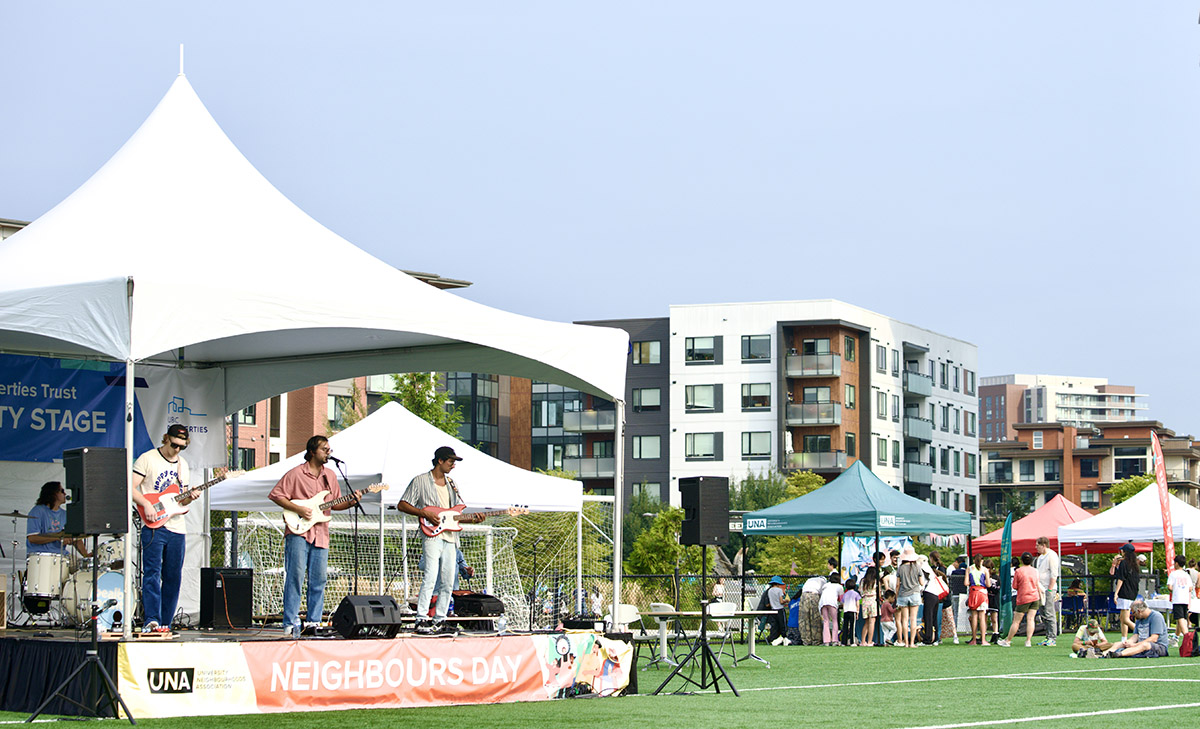The UNA continues to evolve alongside one of the fastest-growing residential communities in Metro Vancouver. As UBC’s neighbourhoods expand, the UNA’s responsibilities have increased in scope and complexity, ranging from community programs and facility management to resident engagement and infrastructure maintenance. With this growth comes the need for a larger, more cohesive staff team to serve residents effectively.
Today, however, the UNA’s administrative operations remain fragmented. Some employees work from the main office at 5923 Berton Ave., a small space long past its functional capacity, while others are based at the Wesbrook Community Centre and the Old Barn Community Centre. This separation limits collaboration and reduces the availability of community-centre space that could otherwise support additional programming, including free or low-cost activities for residents facing financial hardship.
To address these challenges, the UNA has an opportunity to move its main office and the association’s scattered staff to the 3rd floor of their current building, where a larger unit is available for lease by the university through its affiliate UBC Properties Trust (UBCPT).
The goal is sound: to bring the full team together in one efficient, well-designed workspace suitable for both current and future needs.
The real question is not whether to proceed, but how far to go. What level of investment is prudent, and how can the UNA’s Board of Directors ensure accountability to the residents who ultimately fund the organization?
Rising estimates and fiscal prudence
When the office expansion plan was first introduced in April 2024, the total project cost to renovate the 3rd floor unit – including the tenant-improvement contribution from prospective landlord UBC Properties Trust – was estimated at about $650,000. At that time, I proposed setting a cap of $450,000 for the UNA’s contribution, but that limit was not adopted.
Since then, project costs have escalated significantly. Current estimates place the total at roughly $1.27 million. By industry standards, once firm quotes are obtained, there could be a 10 to 20 percent range of variation. The final cost could possibly reach $1.4 million or more. Clearly this is beyond what is reasonable.
Partnership and fairness
The UNA contributes directly to the success and desirability of UBCPT’s portfolio of housing and commercial properties. It invests in neighbourhood safety, maintains landscaping and infrastructure, advocates for schools and healthcare, and delivers the community programming that makes these neighbourhoods attractive places to live.
Given this contribution, UBCPT’s support for the renovation’s costs should reflect the tangible value the UNA provides. I see this support being shared on a 50/50 basis.
UBCPT’s has offered an estimated $180,000 construction allowance to the UNA if it signs the lease for the 3rd floor unit. That amount would go towards renovations that need to be made to make the space suitable as an office space, however that amount is modest relative to a project in the $1.2 to $1.4 million range.
A more balanced approach would first set a construction cap of $1 million, with UNA’s portion and UBCPT’s portion each being $500,000. The exact formula needs to be worked out, but in the end each partner’s share is the same.
Over a ten-year lease term, the UNA will be making significant lease payments to UBCPT along with $500,000 in capital improvements that directly enhances a UBCPT property. Asking UBCPT to participate at a higher level than they’ve currently offered is not unreasonable. It represents a fair recognition of the partnership between the two organizations.
Cost controls and accountability
From a governance standpoint, the UNA’s financial capital commitment for office space should be capped at $500,000, representing a balanced and defensible limit which would still reach efficiency objectives for the team.
The project’s scope should be limited to essential functional needs and non-critical improvements should be phased in only when funding and necessity align. Additionally, all aspects of the project should be transparent with competitive procurement practices and independent cost validation.
These measures ensure that every dollar spent is justifiable, transparent, and aligned with community expectations.
Looking ahead
The UNA office project represents more than a construction decision—it is a reflection of the UNA’s governance maturity. The Board’s approach will signal whether it can invest in operational improvements while upholding the principles of fairness, partnership, and accountability that residents expect.
As the UNA continues to grow, residents deserve full clarity on project costs, funding sources, and longterm implications. Transparency is not optional; it is the foundation of community confidence.
By maintaining that commitment to openness and fiscal responsibility, the UNA can deliver a practical, well-designed workspace that meets staff needs today while ensuring that every dollar spent will contribute lasting value for tomorrow.
Balancing these competing needs lies at the core of good governance. Fiscal prudence does not mean standing still; it means advancing responsibly.
A carefully scoped renovation within clear limits and supported by a fair cost-sharing structure with UBCPT can strengthen UNA operations without compromising resident trust or future programming capacity.
The UNA and UBCPT needs to hear from the residents.
(Editor’s Note: What are your thoughts? Share your opinion by writing a letter to editor@thecampusresident.ca.)
JAKE WIEBE IS A UNA DIRECTOR AND CHAIR OF THE UNA FINANCE AND AUDIT COMMITTEE. THE VIEWS EXPRESSED IN THIS ARTICLE ARE HIS OWN AND DO NOT REPRESENT THOSE OF THE UNA OR UBC.
